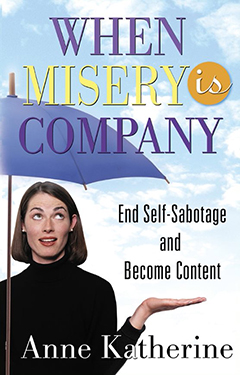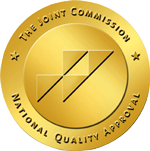
"Everyone screws up now and then and loses an opportunity. All of us get distracted from our main goal on occasion. But when such things happen in a pattern, either cyclically or routinely, there's a problem."

Other titles you may like.

Boundaries:
Where You End and I Begin

The Next Happy:
Let Go of the Life You Planned
and Find a New Way Forward

Of Course You're Angry:
A Guide to Dealing with the
Emotions of Substance Abuse
Visit Recovery Road to view and
listen to all the episodes.
Episode 209 -- April 14, 2022
Twelve Signs of Misery Addiction
Sometimes the only thing holding us back is ourselves. Even once we are sober and well into our recovery, we may expect bad things to happen in our lives—we might be addicted to misery. Many of us doubt ourselves and often try to hide our fear of disappointment by not even trying at all. We may do this to avoid failure, but not showing up for ourselves usually leads to more doubt and disappointment. Once we recognize this cycle and learn how to interrupt it by embracing our potential, we can start living more fulfilling lives.
In her book When Misery is Company, Anne Katherine helps those of us who feel comfortable in our misery find a new path toward greater happiness. The program in this book offers hope that our lives can be better and can empower us to go after happiness instead of keeping it at bay.
The following excerpt introduces twelve examples of self-sabotaging patterns that perpetuate unhappiness and can keep us stuck. It also points us beyond these patterns, inviting us to become more mindful in our activities. Those of us in recovery can look at our lives with a new perspective. We can begin to ask ourselves tough questions: What do we truly desire? How are we holding ourselves back—and how can we stop?
This excerpt has been edited for brevity
A Look in the Mirror
An alcoholic is an alcoholic, period. Once you're over the line into true alcohol addiction, you can't be a partial or some-of-the time alcoholic.
The number of smokers who can take or leave nicotine is slim indeed. Most of us who have smoked (including me and many other people who have successfully quit) found a ferocious struggle in escaping the addiction.
Misery addiction, in contrast, falls along a continuum. On the far end are misery addicts who have seriously curtailed their lives and are unable to stop themselves from ongoing sabotage. On the other end are people who keep themselves a little bit unhappy—not actually staying miserable, but shying away from fulfillment. The amount of effort required to begin recovering from a misery addiction is determined in part by your place on the continuum.
The following list pulls together various aspects of misery addiction:
- Having a pattern of self-sabotage
- Being avoidant
- Having a fear of well-being, happiness, or success
- Not acting when action is required
- Being indecisive
- Being ambivalent
- Not changing your behavior even after it repeatedly causes problems
- After discovering a pattern, not adjusting to deal with it
- Being resistant
- Isolating
- Resist asking for or receiving help
- Having multiple addictions or compulsive behaviors
All of us do some of these things from time to time, and not every misery addict will do everything on the list. What differentiates a misery addict is that she is locked into a pattern of many of these attitudes and actions. As a result, progress toward realizing her goals is blocked, and a significant portion of her daily experience is unsatisfying. A misery addict is rarely content—numbed, maybe, through the use of a tool addiction, but not content, rarely or never resting in moments of quietude and serenity.
Let's go back through the items on this list in more detail.
HAVING A PATTERN OF SELF-SABOTAGE
This consists of recurrent actions (or nonactions) that lead to negative consequences—consequences that are often disproportionately costly or painful.
BEING AVOIDANT
Examples of avoidant behavior are not stepping all the way into experiences, intimacy, or feelings—not being fully present to life.
HAVING A FEAR OF WELL-BEING, HAPPINESS, OR SUCCESS
Amy struggled for years to become a college professor, gathering credentials, teaching 8:00 A.M. classes, and surviving the tenure process. Now, at last, she had made it. She was teaching classes she liked. She was respected by her colleagues. Then she won a poetry award that gave her academic acclaim and made her name known at faculty gatherings.
Yet it made her nervous. She wasn't used to things going well. She was used to struggling. She wasn't accustomed to actually having arrived at the end of the struggle.
Instead of an increasing feeling of well-being, Amy felt dread building. She was nervously waiting for the shoe to drop. The danger is that she may cause the shoe to drop in order to break the suspense. She may even design and build the shoe.
She lives inside the terrible paradox of misery addiction, unable to enjoy positive events and feeling more comfortable with struggle. From that position, it can feel better to stop the flow of goodness than to wait in suspense for someone else to do it.
NOT ACTING WHEN ACTION IS REQUIRED
When Samantha was offered a chance to represent her company at the national convention in Chicago—both an honor and a perk—she froze. She thought of a million reasons why she shouldn't go.
She didn't deserve it. Colleagues would envy her, and therefore resent her, and therefore sabotage her. The cat would miss her. She hadn't been east of the Rockies before. Big cities scared her.
Turning it down would feel safer, more comfortable, more routine. It would also take her out of the running for the A-list. To refuse the company's vote of confidence would cause a shift in attitude that would alter the opportunities presented to her in the future.
She took a long time to decide. Her hesitation was in itself a message to her company. Delaying or not acting when action is needed is a classic symptom of misery addiction.
BEING INDECISIVE
The misery addict waaffles back and forth, losing a lot of time and missing opportunities through a failure to decide.
BEING AMBIVALENT
She wants intimacy. She fears it.
He wants to marry Suzanne. He's scared of the idea of marriage.
NOT CHANGING YOUR BEHAVIOR EVEN AFTER IT REPEATEDLY CAUSES PROBLEMS
Serena had a penchant for locking herself out of the house. The obvious (and common) solution was to plant extra keys in various spots. But Serena had to lock herself out nine times before she finally had spare keys made.
AFTER DISCOVERING A PATTERN, NOT ADJUSTING TO DEAL WITH IT
In fact, after Serena locked herself out for the fifth time, her husband noticed that she did this when she was stressed and told her so. Once she knew the pattern, then she had an opportunity to create a plan around it.
But a misery addict often doesn't adjust, even when the handwriting is clearly visible on the wall. Thus she sets herself up to go through the negative experience yet again.
BEING RESISTANT
He wants his life to change but resists the therapist's efforts.
She wants to join the inner circle of the Weaver's Club but re-sists overtures of inclusion.
ISOLATING
A misery addict feels alone in the world. He may be the life of the party, but he is crying inside. Purposely or inadvertently, he does things that create a barrier or distance from others.
RESIST ASKING FOR OR RECEIVING HELP
A misery addict will sweat through an overwhelming task rather than ask for help. When help is offered, she is likely to turn it down, even if it is desperately needed.
HAVING MULTIPLE ADDICTIONS OR COMPULSIVE ACTIVITIES
Involvement in a mixture of activities such as compulsive gambling, shopping, eating, or game-playing and/or use of various substances to alter mood or feeling serve the triple purpose of checking out, soothing pain, and causing more misery.
Everyone screws up now and then and loses an opportunity. All of us get distracted from our main goal on occasion. But when such things happen in a pattern, either cyclically or routinely, there's a problem.
YOUR CHOICE
One of my clients was recently criticizing herself for the years she had lost to indecision, inaction, or mistakes. In fact, she has lost many years due to criticizing herself. Clearly, each new year of self-judging causes her to lose another year. If her goal is to be endlessly angry with herself, then she will succeed, because this is working. Meanwhile, life continues to pass her by.
I asked her if four years from now, when she will be sixty, will she want to look back on four years of interesting activities or on sixty years of feeling like a failure? She smiled in recognition. Even though she is comfortable with defeat, she has worked hard enough therapeutically that she was able to honestly say that she wanted to look back on four good years.
This is your decision now. Is it worth it to you to work hard—sometimes very hard—for a few years so that you can feel joy as joy and so that happiness makes you happy? Would you like to have a real say in the course your life takes?
If your answer is yes but you feel scared, that's okay. It's okay to be scared at the prospect of happiness. Everyone gets scared at first by the prospect of big change, even if it's positive.
This book is about how to navigate these new and uncharted waters, about living a life that's truly fulfilling.
About the Author:
Anne Katherine is a licensed mental health counselor, a board certified regression therapist, a certified eating disorders specialist, and a registered hypnotherapist.
© 2004 by Anne Katherine.
All rights reserved

